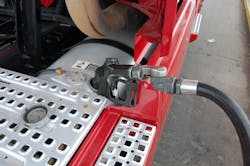Diesel keeps declining while gasoline reverses course
The U.S. national average retail pump price for diesel kept dropping this week, with every region of the country reporting a decline, according to data tracked by the Energy Information Administration (EIA).
By contrast, the national average retail pump price for gasoline increased this is week, with six out of nine regions across the U.S. reporting an uptick in prices – though the agency’s short-term energy outlook projects gasoline to stick to a downward price trend for the fourth quarter of this year on into 2014.
The average retail pump price for diesel prices declined one cent to $3.822 per gallon this week, according to the EIA’s data, which is 15.4 cents cheaper per gallon compared to the same week in 2012.
Diesel pump prices declined in every region of the nation, the agency said, with only California reporting prices over the $4 per gallon mark ($4.022 per gallon to be exact). California is also home to the largest one-week drop in diesel prices – 3.3 cents per gallon – while the Gulf Coast is home to the cheapest diesel in the country this week at $3.745 per gallon, EIA noted.
Conversely, the national average retail pump price for gasoline increased 2.5 cents to $3.219 per gallon this week, though that is 21 cents per gallon cheaper compared to the same week in 2012, EIA’s figures indicated.
Gasoline prices increased in every region of the U.S. except for the Rocky Mountains, where prices declined 4.4 cents to $3.183 per gallon, and the West Coast, which experienced a 4 cent drop to $3.467 per gallon – a figure that takes top honors as the highest price for gasoline in the nation for this week.
With California taken out of the mix, though, the average retail pump price for gasoline on the West Coast fell 3.6 cents to $3.306 per gallon this week, according to the agency.
EIA added, however, that it expects regular-grade gasoline retail prices – which averaged $3.34 per gallon during October – to drop down to an average of $3.24 per gallon during the fourth quarter this year.
Led by falling Brent crude oil prices, the projected U.S. annual average regular gasoline retail price falls from $3.63 per gallon in 2012 to an average of $3.50 per gallon in 2013 and $3.39 per gallon by 2014.
Diesel is expected to follow the same downward price slope, EIA indicated, dropping from an average of $3.97 per gallon in 2012 to finish out 2013 at $3.91 per gallon and reach $3.73 per gallon in 2014.
Those price declines are partly attributed to increased U.S. crude oil production by the agency; production that averaged 7.7 million barrels per day (bbl/d) in October. Monthly estimated domestic crude oil production exceeded crude oil imports in October for the first time since February 1995, EIA said, while total petroleum net imports were the lowest since February 1991.
The agency also predicts U.S. crude oil production will average 7.5 million bbl/d by the close of 2013 and then rise in 2014 to 8.5 million bbl/d.
About the Author
Sean Kilcarr
Editor in Chief
Sean Kilcarr is a former longtime FleetOwner senior editor who wrote for the publication from 2000 to 2018. He served as editor-in-chief from 2017 to 2018.
